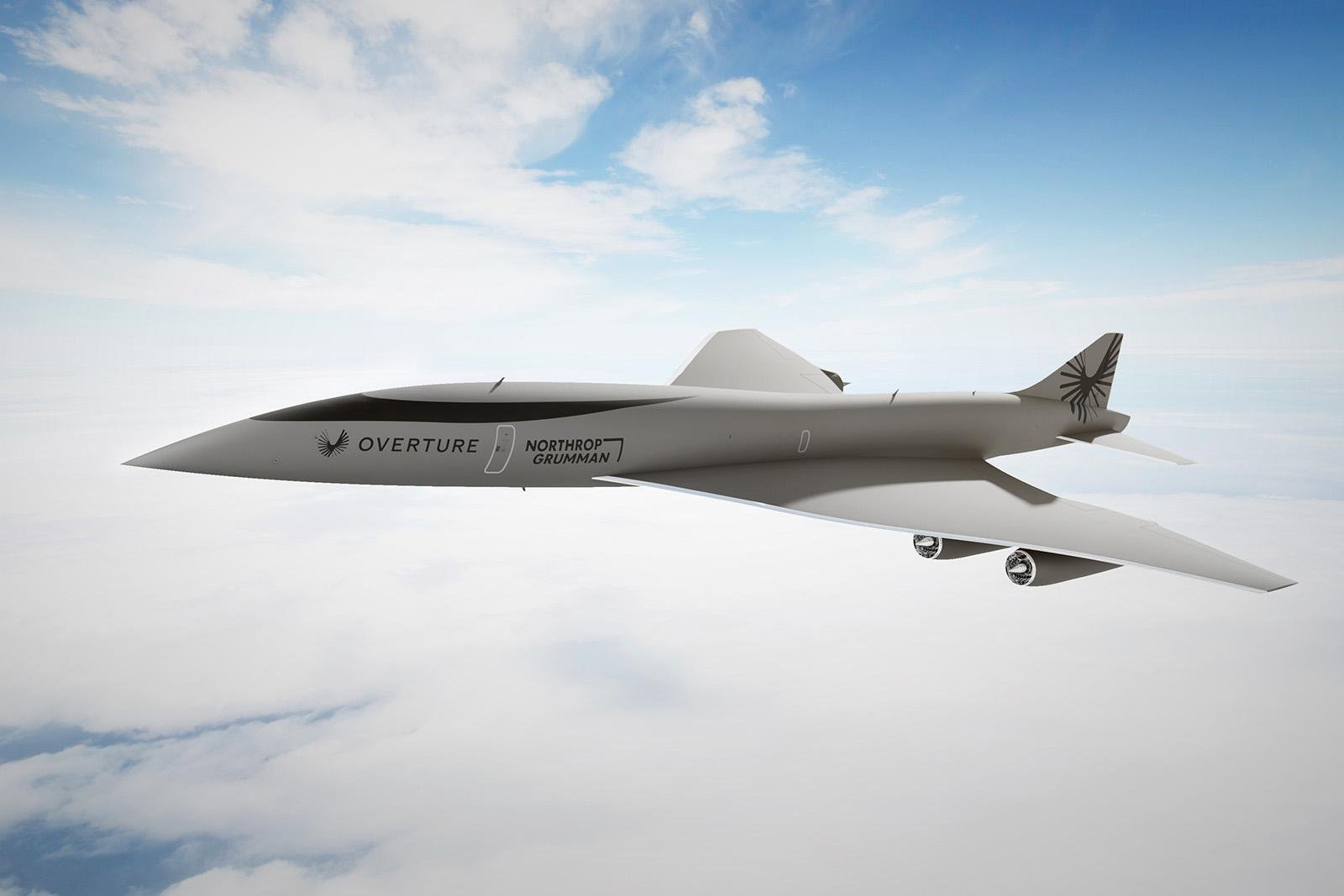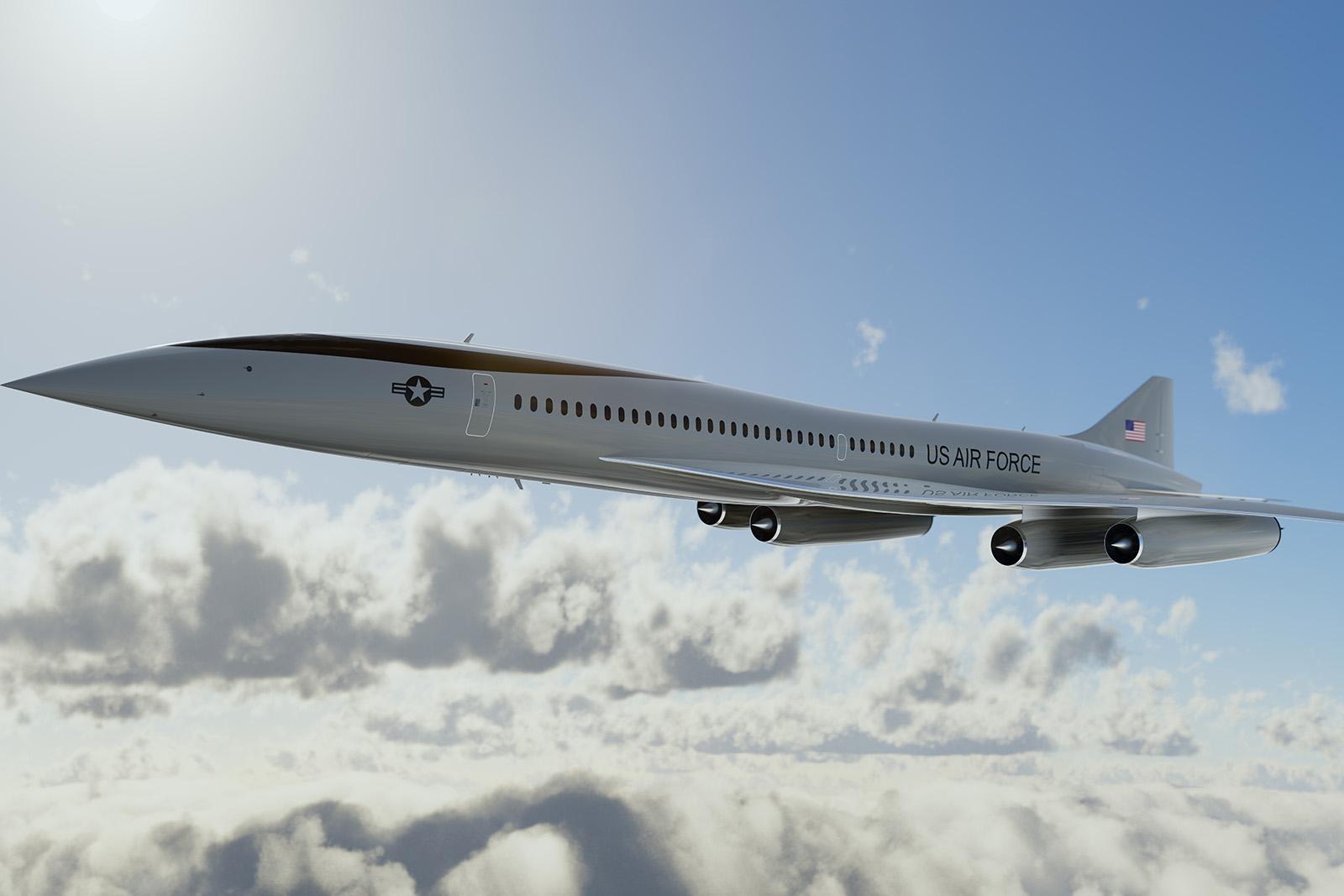
FARNBOROUGH—Supersonic airliner developer Boom has unveiled the refined configuration of its Mach 1.7 Overture passenger design and, at the same time, announced a partnership with Northrop Grumman to study military versions.
The significantly revised Overture design is tailored to meet Boom’s 4,250-nm range, high-speed mission requirement with 65-80 passenger, while simultaneously meeting stringent International Civil Aviation Organization (ICAO) Chapter 14/FAA Stage 5 takeoff-and-landing noise limits. Reminiscent of supersonic concepts studied by Boeing and McDonnell Douglas in the late 1980s under NASA’s High Speed Civil Transport project, the new design features a horizontal tail and four wing-mounted engines, replacing the trijet arrangement of the earlier concept.
By increasing the number of engines, Boom says the Overture will be capable of takeoff at derated thrust settings, helping reduce noise. Mounted in individual nacelles, the nonafterburning engines are staggered along the trailing edge of a large delta wing, which replaces the slender ogive design of the previous Concorde-like iteration. The new wing is gulled in profile and incorporates what appears to be a sharper trailing edge sweep angle inboard with a reduced sweep outboard.
The revised wing is designed to provide improved lateral stability as well as additional lift at subsonic conditions without compromising supersonic cruise performance—enabling transonic overland flight close to Mach 1 and long-range overwater flights at Mach 1.7. The engine arrangement also reduces aerodynamic interference drag while providing space for high-lift trailing edge devices. The aft location also complies with positioning rules for modern turbine rotor burst safety regulations and places the engines aft of the cabin pressure bulkhead.
Boom says the decision to adopt the four-engine configuration was also driven by “the supply chain capabilities of our partners. Using four engines lets us shrink the size of each engine, allowing production to fall within current supply chain and manufacturing capabilities—all while reducing the noise levels of the aircraft.”
The Colorado-based company adds that using four engines instead of three also “keeps weight and temperature within existing technology constraints while allowing Overture to work within established supply chain and maintenance norms. An earlier three-engine design included an engine in the tail and using four identical engine installations reduces costs and streamlines maintenance for our customers.”

The radical redesign is “the culmination of hours of simulated software designs, five wind tunnel tests, and the careful evaluation of 51 full design cycles, resulting in the most environmentally and economically sustainable supersonic airliner ever developed,” says Boom. The updated design will also include the use of an automated noise reduction system and advanced takeoff procedures to help reduce noise along lateral sidelines.
Another new feature is an area-ruled fuselage, which has been added to minimize drag at supersonic speeds. Area rule compensates for the increase in cross-sectional area around the wing-body join area by indenting the fuselage, helping to reduce the peak value of the drag at Mach 1 and enabling supersonic speeds with less thrust.
Compared to previously published information the length of the revised Overture has now been shortened slightly by around 5 ft. to 200 ft/, while the wingspan has increased significantly from 60 ft. to 105 ft. The cabin will be 79 ft. long, and up to 6.5 ft. high at aisle. The forward and aft fuselage cross-section will also be wider than the midsection due to the use of area ruling.
Additionally, the company has announced the start of outfitting an Iron Bird ground test facility in Centennial, Colorado, where the XB-1 subscale flight test vehicle has also been developed. The new 70,000-ft.2 site will house the full-scale Overture testing model and flight deck simulators. The test model will be used for integrating Overture’s flight hardware, software, and systems—including a quad-redundant fly-by-wire flight control system. Newly announced suppliers to the program include Collins Aerospace for avionics, air data and ice protection, Eaton for fuel distribution and inerting, and Safran Landing Systems for the landing gear.
Boom has yet to announce details of the engine itself and has been working with Rolls-Royce–developer of the Concorde’s Olympus engine with Safran (formerly Snecma)–on concept studies. Chris Cholerton, president of Civil Aerospace for Rolls-Royce, says “we just completed some studies of engine technology with Boom, so we are talking about what we might do next—but nothing specific has been agreed. It’s been a valuable exercise and we continue talks with Boom.” Despite continuing uncertainty over the engine choice, Boom says it remains on track to begin production of the Overture prototype in 2024. The current schedule calls for rollout in 2025, flight test in 2026 and entry into service in 2029.
The airframe manufacturer has also announced a strategic partnership with Northrop Grumman to develop a special mission variant for the U.S. Government and its allies. The work follows the award earlier in 2022 of a three-year U.S. Air Force contract to expand studies of the Overture beyond that of an executive transport to include surveillance, reconnaissance, special forces deployment and other military transport roles.
“Potential applications for the supersonic aircraft include quick-reaction surveillance and reconnaissance, command and control, as well as mobility and logistics missions, such as emergency medical evacuation and troop transport,” says Boom. “Depending on the nature of the offering and specific customer requirements, Northrop Grumman will lend its expertise as a prime defense systems integrator to act as the lead industry partner, while Boom would provide the aircraft,” it adds.
Boom’s U.S. Air Force work was contracted through the Air Force’s Afwerx innovation arm, and through the service’s AFVentures division, which is designed to accelerate commercial technologies. Known as the Strategic Funding Increase, the contract followed a smaller Small Business Innovation Research (SBIR) Phase 2 contract in September 2020 aimed principally at studies of a potential supersonic Air Force One presidential and executive transport.
